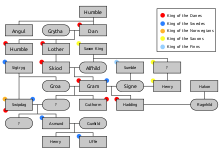Gríðr
Gríðr (or Gríd) is a jötunn in Norse mythology. She is the mother of Víðarr the silent and the consort of Oðinn.[1]
| Gríðr | |
|---|---|
| Queen of the Danes | |
| Successor | Alfhild |
| Consort | Dan I |
| Issue | Humble Lother |
| Religion | Pagan |
| Characters of Gesta Danorum |
|---|
 |
| Danish kings |
| Foreign rulers |
| Other men |
| Women |
Name
The poetic Old Norse name Gríðr has been translated as "vehemence, violence, or impetuosity".[2][3][4] Its etymology is unclear.[2]
Attestations
Prose Edda
In Skáldskaparmál (The Language of Poetry), Gríðr is portrayed as equipping the thunder-god Thor with her belt of strength, her iron glove, and her staff Grídarvöl (Gríðr's-staff) on Thor's journey to the abode of Geirröðr.[1]
Thor lodged for the night with a giantess called Grid. She was Vidar the silent’s mother. She told Thor the truth about Geirrod, that he was a cunning giant and awkward to deal with. She lent him a girdle of might and some iron gauntlets of hers, and her staff, called Grid’s pole.
Gríðr is also mentioned in a list of troll-wives ("I shall list the names of troll-wives. Grid and Gnissa, Gryla...").[5]
Viking Age
Grídarvöl (Gríðr's-staff) is also mentioned in the poem Þórsdrápa by the late 10th-century skald Eilífr Goðrúnarson.[6]
The feller of the dolphins of the steeps [giants] advanced with violent temper with Grid’s pole.
Gríðr appears in 10th-century kennings for 'wolf' (the steed of troll-wife) and for 'axe' (that which is dangerous to the life-protector, i.e. shield or helmet).[7]
Battle raged when the feeder of Grid’s steed [wolf], he who waged war, advanced with ringing Gaut’s [Odin’s] fire. Weird rose from the well.
— Kormákr Ögmundarson, Skáld. 49, trans. A. Faulkes, 1987.
Riders [seafarers] of Ræfil’s land’s [sea’s] horses [ships] can see how beautifully engraved dragons lie just by the brow of the Grid of the life-protector.
— Einarr Skúlason, Skáld. 49, trans. A. Faulkes, 1987.
Other texts
Saxo Grammaticus refers to her as Grytha, the wife of the legendary king Dan I of Denmark, "a matron most highly revered among the Teutons". A witch of the same name appears in Illuga saga Gríðarfóstra.
Theory
Her role as the donor of information and necessary items to the hero has been analyzed by folklorists as a commonplace of folk narrative.[1]
Notes
- Lindow 2002, p. 149.
- de Vries 1962, p. 188.
- Simek 1996, p. 117.
- Orchard 1997, p. 61.
- Faulkes 1987, p. 156.
- Faulkes 1987, p. 84.
- Faulkes 1987, pp. 121, 238.
References
Bibliography
- de Vries, Jan (1962). Altnordisches Etymologisches Worterbuch (1977 ed.). Brill. ISBN 978-90-04-05436-3.
- Faulkes, Anthony, trans. (1987). Edda (1995 ed.). Everyman. ISBN 0-460-87616-3.CS1 maint: ref=harv (link)
- Lindow, John (2002). Norse Mythology: A Guide to Gods, Heroes, Rituals, and Beliefs. Oxford University Press. ISBN 978-0-19-983969-8.
- Orchard, Andy (1997). Dictionary of Norse Myth and Legend. Cassell. ISBN 978-0-304-34520-5.CS1 maint: ref=harv (link)
- Simek, Rudolf (1996). Dictionary of Northern Mythology. D.S. Brewer. ISBN 978-0-85991-513-7.